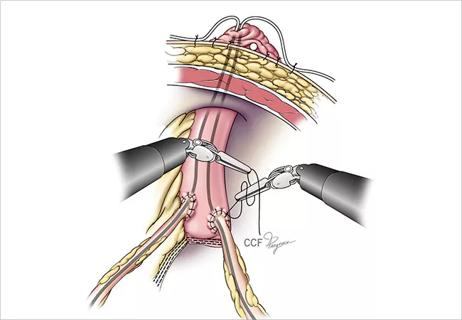Study offers evidence to guide treatment decisions

Benign prostatic hyperplasia (BPH) is a common condition that affects a growing percentage of men as they age. Its symptoms can range widely from mild quality-of-life issues to severe problems such as urinary retention, infections and stones.
Advertisement
Cleveland Clinic is a non-profit academic medical center. Advertising on our site helps support our mission. We do not endorse non-Cleveland Clinic products or services. Policy
The first-line treatment for lower urinary tract symptoms (LUTS) related to BPH has long been medical therapy: monotherapy or combination therapy with a 5-alpha reductase inhibitor and/or an alpha-adrenergic antagonist. The evidence is strong that combination therapy is more effective over time than monotherapy with either medication. While medical therapy may provide long-lasting relief for some men, others will experience BPH progression, medication intolerance or prefer a one-time intervention rather than lifelong treatment.
With the development of new office-based procedures, such as water vapor ablation, and updated 2018 American Urological Association (AUA) guidelines for surgical management of BPH, Cleveland Clinic urologists were interested to know: “What is the most economically sound way to treat BPH and how would it align with the new AUA guidelines?” says Bradley Gill, MD, of the Glickman Urological & Kidney Institute’s Department of Urology.
Dr. Gill and James Ulchaker, MD, of the Department of Urology, conducted a study comparing the relative costs of BPH treatments from a payer perspective, using Medicare data. Here’s what they found for medical, surgical and office-based therapy:
Various alpha-adrenergic antagonists are available that achieve similar clinical efficacy. According to the Medicare website, the costs for this class of medication range from $46/month or $552/year for terazosin to $299/month or $3,588/year for silodosin. The two 5-alpha reductase inhibitors also provide comparable clinical efficacy; their costs range from $92/month or $1,104/year for finasteride to $166/month or $1,992/year for dutasteride, with less cost variability since their non-urologic indications are limited.
Advertisement
The new AUA surgical guidelines provide an algorithm that emphasizes the size of the prostate as a primary factor in choosing interventions. The recommendations for large prostates are simple prostatectomy or laser enucleation; for average-size glands and smaller glands, the many options include laser vaporization and transurethral resection, along with newer, minimally invasive procedures such as the prostatic urethral lift and water vapor ablation therapy.
“My preference for the average BPH patient is laser prostatectomy or a minimally invasive procedure,” says Dr. Gill.
At Cleveland Clinic, surgical costs, based on 2017 Medicare reimbursement, ranged from $1,677 for outpatient transurethral resection of the prostate (TURP) to $2,127 for laser prostatectomy, with higher costs for procedures warranting inpatient status. Some cost-related factors include operative and convalescent time and equipment costs.
Recent advances in office-based BPH procedures, including the prostatic urethral lift and convective water vapor ablation, have produced promising outcomes in initial reports. They are a good option for men who cannot or choose not to take medications and wish to avoid invasive surgery. Patients generally tolerate these procedures well and may be able to resume normal activity more quickly than with surgery. But their applicability is affected by prostate size and anatomic configuration.
The average Medicare reimbursement for the prostatic urethral lift is $2,721, and convective water vapor ablation is $1,742, based on initial experiences using the therapies.
Advertisement
Regarding cost equivalence among the treatments, the study found that:
These results, which highlight the relative costs of the procedures, do not address the cost-effectiveness of the therapies. However, they do suggest that less costly treatments that may confer an ongoing expense, or risk the need for subsequent treatment, may not be the most economically sound long-term option.
“We were surprised at the relatively short time frame that it takes for BPH procedures to achieve cost equivalence with combination medical therapy,” says Dr. Gill. “This study shows that, at least from an economic standpoint, performing a procedure can be a cost-effective option. If a patient can experience 10 years or more of symptom control from a BPH procedure, the cost savings are substantial.”
Based on this study and others that have looked at BPH treatment costs, “we really need to expand the conversation with patients and be sure they understand all the treatment options,” Dr. Gill says. Medication therapy has an ongoing recurrent cost and some patients may not want to be on lifelong treatment. This study argues to give consideration to upfront surgery.”
Advertisement
Advertisement

Study shows surgical experience impacts the risk of post-operative stricture formation

Assessments of the shorter collection routine are encouraging, but not yet definitive